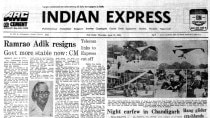- India
- International
Building on Aadhaar
How direct benefit transfers have run into implementation hurdles.
 The UIDAI is a tool. That tool isn’t going to help identify below poverty line households, the beneficiaries of subsidies.
The UIDAI is a tool. That tool isn’t going to help identify below poverty line households, the beneficiaries of subsidies.
As of the first half of March, 786 million of those who are 18 and older have got Aadhaar numbers. The largest absolute numbers are in Maharashtra, Uttar Pradesh and West Bengal. There are two broad channels for Aadhaar enrolment — the Unique Identification Authority of India (UIDAI) itself and the Registrar General of India (RGI). For instance, in Lakshadweep, Dadra & Nagar Haveli, Tamil Nadu, West Bengal, Odisha, Nagaland, Manipur, Jammu and Kashmir, Mizoram, Arunachal Pradesh, Meghalaya and Assam, the enrolment responsibility is with RGI. The UIDAI is responsible for other geographical areas. One test of how enrolment is progressing is to gauge what percentage of the population has been covered. If you want to be statistically correct, this isn’t that simple.
The distribution of the 18-plus population is available for Census 2011, not 2015. One can extrapolate from those numbers to get the denominator. Or, the 2011 numbers can be used as a base, recognising that population growth will mean one may get more than 100 per cent enrolment. For trends, extrapolation seems unnecessary. One may as well use Census 2011 numbers. All enrolment numbers are public-domain information on the UIDAI website. There is also another issue, that of comparing residents to citizens. But that may not be quantitatively important.
For UIDAI-driven enrolment states/UTs, 86 per cent of the target population has been covered, from 127.6 per cent enrolment in Delhi to 46.3 per cent in Bihar. For RGI-driven enrolment states/UTs, 82 per cent of the target population has been covered, ranging from 108 per cent in Lakshadweep to 1.1 per cent in Assam. At that broad-brush level, the UIDAI’s track record is better than the RGI’s. This is clear from average daily enrolments too, running at about 9,40,000 for the UIDAI and 65,000 for the RGI. There are around 111 UIDAI districts where enrolment is still less than 50 per cent and 206 RGI districts where enrolment is less than 50 per cent. But these are stock numbers.
The increments or flows are more important. The story there is a sharp increase in enrolments in UP and a slowing down in Maharashtra, Karnataka, Rajasthan, MP and Gujarat, especially in the more difficult districts. Once people have got Aadhaar numbers, what next? Aadhaar and biometry only ensures there aren’t two individuals with identical names and identical biometry at the same address. It prevents multiplicity. Thereafter, it is a question of what use one makes of Aadhaar. To use technical jargon, Aadhaar must be seeded into assorted programmes. This means: one, beneficiary data must be digitised; two, if beneficiaries don’t possess Aadhaar numbers, they must be enrolled; and three, if they possess Aadhaar numbers, this must be matched with beneficiary databases. So far, the primary success has been in seeding bank accounts (old or new) with Aadhaar numbers.
The next step, which is where beneficiaries come in, is direct benefit transfers (DBTs). In August 2014, a study was undertaken by the then Planning Commission that matched beneficiary data for five schemes (post-matric scholarships for SC/ST/minorities, pensions, the MGNREGA, PDS, subsidised LPG connections) with UIDAI numbers in 300 districts. That exercise is a bit old, so one needn’t state precise findings. Suffice to say that there were major problems with the first point. To the extent digital beneficiary data existed, there were problems with points two and three. I am not aware of robust studies done after, in government or outside it. Anecdotally, that digitisation of the beneficiary database seems to be working better for LPG connections than for scholarships, pensions, the MGNREGA or PDS. Yet another issue makes it worse.

The UIDAI is a tool. That tool isn’t going to help identify BPL (below the poverty line) households, the beneficiaries of subsidies. This is a socioeconomic issue and is important in segments like LPG connections or PDS, where the “poor” aren’t self-identified. The NSS and poverty estimates based on NSS can’t work. The NSS is a survey, not a census. It can tell us what percentage of the population is below the poverty line in say, Maharashtra, regardless of how the poverty line is defined. It can’t tell us whether a specific household is poor or not.
That apart, NSS samples generally surface at intervals of five years. However, we have the rural development ministry’s Socio-Economic and Caste Census (SECC) of 2011. One of its three objectives is, “To enable households to be ranked, based on their socioeconomic status. State governments can then prepare a list of families living below the poverty line.” There can be errors of omission (excluding those who are poor) and commission (including those who are not poor). Therefore, suppressing the religion and caste bit, the rest of the information will be put up in: one, the panchayat office; two, another prominent location in the panchayat; or three, the office of the BDO.
That allows for errors of omission and commission to be taken care of through objections. Hence, there is a draft list. After objections are taken care of, there is a final list. Note that, “No changes would be allowed in the data for one year following the publication of the final list.” That may be operationally necessary. However, in March 2015, final lists are available for only 118 out of 640 districts. Draft lists are available in 541 out of 640 districts. If it takes such a long time to firm up BPL lists, how can DBTs work? Does a household’s status remain invariant for four years and more? None of Tamil Nadu’s districts figure in either the draft or final lists. But the process was supposed to be completed in June 2013, with initial enumeration over by September 2012. Tamil Nadu isn’t the only state with such a timelag. An inherently good idea (DBT) is still partly stuck in the pipeline of implementation.
The writer is member, Niti Aayog. Views are personal
EXPRESS OPINION
More Explained
Apr 19: Latest News
- 01
- 02
- 03
- 04
- 05









































